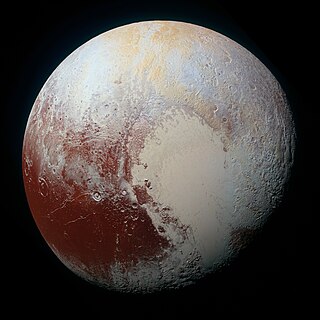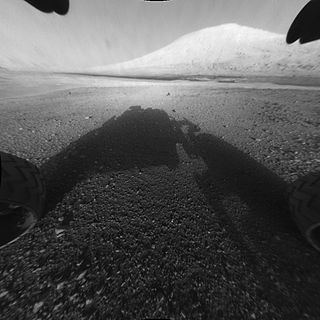
Planetary nomenclature, like terrestrial nomenclature, is a system of uniquely identifying features on the surface of a planet or natural satellite so that the features can be easily located, described, and discussed. Since the invention of the telescope, astronomers have given names to the surface features they have discerned, especially on the Moon and Mars. To found an authority on planetary nomenclature, the International Astronomical Union (IAU) was organized in 1919 to designate and standardize names for features on Solar System bodies.

Vesta is one of the largest objects in the asteroid belt, with a mean diameter of 525 kilometres (326 mi). It was discovered by the German astronomer Heinrich Wilhelm Matthias Olbers on 29 March 1807 and is named after Vesta, the virgin goddess of home and hearth from Roman mythology.

The B612 Foundation is a private nonprofit foundation headquartered in Mill Valley, California, United States, dedicated to planetary science and planetary defense against asteroids and other near-Earth object (NEO) impacts. It is led mainly by scientists, former astronauts and engineers from the Institute for Advanced Study, Southwest Research Institute, Stanford University, NASA and the space industry.

Areography, also known as the geography of Mars, is a subfield of planetary science that entails the delineation and characterization of regions on Mars. Areography is mainly focused on what is called physical geography on Earth; that is the distribution of physical features across Mars and their cartographic representations.

The SETI Institute is a not-for-profit research organization incorporated in 1984 whose mission is to explore, understand, and explain the origin and nature of life in the universe, and to use this knowledge to inspire and guide present and future generations, sharing knowledge with the public, the press, and the government. SETI stands for the "search for extraterrestrial intelligence".

Planetary geology, alternatively known as astrogeology or exogeology, is a planetary science discipline concerned with the geology of celestial bodies such as planets and their moons, asteroids, comets, and meteorites. Although the geo- prefix typically indicates topics of or relating to Earth, planetary geology is named as such for historical and convenience reasons; due to the types of investigations involved, it is closely linked with Earth-based geology. These investigations are centered around the composition, structure, processes, and history of a celestial body.
Paul D. Spudis (1952–2018) was an American geologist and lunar scientist. His specialty was the study of volcanism and impact processes on the planets, including Mercury and Mars.

Sol Alan Stern is an American engineer and planetary scientist. He is the principal investigator of the New Horizons mission to Pluto and the Chief Scientist at Moon Express.

Gerald A. Soffen was a NASA scientist and educator who served in a wide variety of roles for the space agency, primarily dealing with either education or with life sciences—especially the search for life on Mars.

James F. Bell III is a professor of Astronomy at Arizona State University, specializing in the study of planetary geology, geochemistry and mineralogy using data obtained from telescopes and from various spacecraft missions. Bell's active research has involved the NASA Mars Pathfinder, Near Earth Asteroid Rendezvous (NEAR), Comet Nucleus Tour (CONTOUR), 2001 Mars Odyssey, Mars Reconnaissance Orbiter, Lunar Reconnaissance Orbiter, and the Mars Science Laboratory missions. His book Postcards from Mars includes many images taken by the Mars rovers. Bell is currently an editor of the space science journal Icarus and president of The Planetary Society. He has served as the lead scientist in charge of the Panoramic camera (Pancam) color imaging system on Mars rovers Spirit and Opportunity.

The Space Science Institute (SSI) in Boulder, Colorado, is a nonprofit, public-benefit corporation formed in 1992. Its purpose is to create and maintain an environment where scientific research and education programs can flourish in an integrated fashion. SSI is among the four non-profit institutes in the US cited in a 2007 report by Nature, including Southwest Research Institute, Planetary Science Institute, and Eureka Scientific, which manage federal grants for non-tenure-track astronomers.

Jezero is a crater on Mars in the Syrtis Major quadrangle, about 45.0 km (28.0 mi) in diameter. Thought to have once been flooded with water, the crater contains a fan-delta deposit rich in clays. The lake in the crater was present when valley networks were forming on Mars. Besides having a delta, the crater shows point bars and inverted channels. From a study of the delta and channels, it was concluded that the lake inside the crater probably formed during a period in which there was continual surface runoff.

Mount Sharp, officially Aeolis Mons, is a mountain on Mars. It forms the central peak within Gale crater and is located around 5.08°S 137.85°E, rising 5.5 km (18,000 ft) high from the valley floor. Its ID in the United States Geological Survey's Gazetteer of Planetary Nomenclature is 15000.

Ellen Renee Stofan is Under Secretary for Science and Research at The Smithsonian and was previously the John and Adrienne Mars Director of the National Air and Space Museum.

Nadine G. Barlow (1958-2020) was an American planetary scientist. She was a professor in the Department of Physics and Astronomy at Northern Arizona University (NAU). She became Associate Chair of the NAU Department of Physics and Astronomy in Fall 2010. She was also the director of the Northern Arizona University/NASA Space Grant Program and an associate director of the Arizona Space Grant Consortium.

Garni is an impact crater on Mars, in which, according to NASA, there is evidence of liquid water. In the press release of its finding on 28 September 2015, NASA considered it "the latest of many breakthroughs" in their Mars exploration. NASA and the US Geological Survey named the crater after the Armenian village of Garni. The naming was approved and adopted by the International Astronomical Union (IAU) on April 24, 2015.

Farim is the name of an impact crater on the planet Mars, located inside a chain of unnamed craters bordering the northern rim of the larger Kepler crater. The crater's name, approved by the International Astronomical Union (IAU) on 11 March 2013, is derived from the town of Farim in Guinea-Bissau. Farim crater was described as a feature on Mars as early as 1971 in that year's edition of the Times Atlas of the World, and recently became of interest to scientists working on the 2001 Mars Odyssey mission, after the spacecraft's THEMIS camera made two surveys of Farim in December 2016.
The Cyprus Space Exploration Organisation (CSEO) is a non-governmental, nonprofit, science organisation, based in Cyprus, with a global scope of service and activities. Its main functions are research and development, space advocacy, and international cooperation in the field of space exploration, astronautics and astronomy. Education and outreach are also an important part of its mission as International Astronomy Education Centre.















